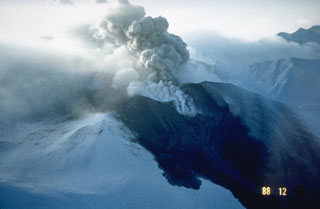Report on Tokachidake (Japan) — February 1989
Scientific Event Alert Network Bulletin, vol. 14, no. 2 (February 1989)
Managing Editor: Lindsay McClelland.
Tokachidake (Japan) One new explosion; seismicity declines
Please cite this report as:
Global Volcanism Program, 1989. Report on Tokachidake (Japan) (McClelland, L., ed.). Scientific Event Alert Network Bulletin, 14:2. Smithsonian Institution. https://doi.org/10.5479/si.GVP.SEAN198902-285050
Tokachidake
Japan
43.418°N, 142.686°E; summit elev. 2077 m
All times are local (unless otherwise noted)
During the first eight days in February, five explosions from crater 62-2 were recorded. On 5 March at 0522, a brief eruption occurred after 25 days of quiet. No ground shocks were felt, but small earthquakes were recorded at 0522, 0524, and 0526. Volcanic tremor was intermittently recorded 0523-0725 by a seismograph 4.5 km NNW of the 1962 craters. Cloudy weather obscured the active crater, but when visibility returned, a blackish-gray plume was observed at 0810. A 1-km-long, narrow mudflow, produced by the eruption, descended NW along the same path as December-February mudflows and pyroclastic flows. A small amount of ashfall was reported ~25 km SE of the 1962 craters.
A total of 21 eruptions have been recorded or observed (table 1) since 16 December 1988. The seismograph 4.5 km NNW of crater 62-2 recorded 49 earthquakes in February (see figure 4). Seismicity declined to low levels after mid-February. A grayish-white plume steadily rose 300-500 m above crater 62-2.
Table 1. Eruptions at Tokachi from 16 December 1988 through 5 March 1989. Courtesy of JMA.
| Date | Time | Ashfall area | Comments |
| 16 Dec 1988 | early | 80 km SE | -- |
| 18 Dec 1988 | 0840 | 60 km | -- |
| 19 Dec 1988 | 2148 | more than 150 km | Largest ashfall, mudflow. |
| 24 Dec 1988 | 2212 | 80 km | Mudflow, evacuation. |
| 25 Dec 1988 | 0049 | 80 km | Pyroclastic flow. |
| 30 Dec 1988 | 0527 | 40 km SE | -- |
| 01 Jan 1989 | 0212 | -- | -- |
| 08 Jan 1989 | 1938 | 40 km SE | -- |
| 16 Jan 1989 | 1855 | 40 km SE | Pyroclastic flow. |
| 20 Jan 1989 | 0322 | 20 km E | -- |
| 22 Jan 1989 | 0014 | -- | -- |
| 27 Jan 1989 | 0144 | -- | -- |
| 28 Jan 1989 | 0518 | 80 km E | -- |
| 28 Jan 1989 | 0611 | 80 km E | -- |
| 28 Jan 1989 | 0700 | 80 km E | -- |
| 01 Feb 1989 | 1818 | 80 km E | -- |
| 04 Feb 1989 | 0038 | 110 km SE | -- |
| 06 Feb 1989 | 0937 | 40 km E | -- |
| 07 Feb 1989 | 2354 | -- | -- |
| 08 Feb 1989 | 0402 | 140 km E | Pyroclastic flow. |
| 05 Mar 1989 | 0522 | 25 km SE | Mudflow. |
Further Reference. Special Section: The 1988-1989 eruption of Mt. Tokachi, central Hokkaido: Bulletin of the Volcanological Society of Japan, v. 35, no. 2 (July 1990), p. 111-215 (6 papers, in English).
Geological Summary. Tokachidake volcano consists of a group of dominantly andesitic stratovolcanoes and lava domes arranged on a NE-SW line above a plateau of welded Pleistocene tuffs in central Hokkaido. Numerous explosion craters and cinder cones are located on the upper flanks of the small stratovolcanoes, with the youngest Holocene centers located at the NW end of the chain. Frequent historical eruptions, consisting mostly of mild-to-moderate phreatic explosions, have been recorded since the mid-19th century. Two larger eruptions occurred in 1926 and 1962. Partial cone collapse of the western flank during the 1926 eruption produced a disastrous debris avalanche and mudflow.
Information Contacts: JMA.

